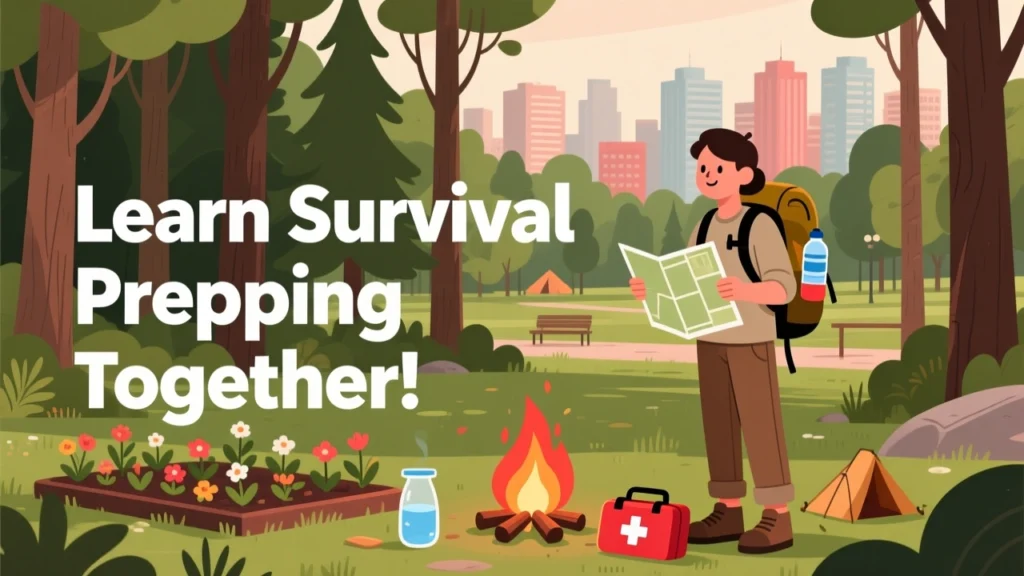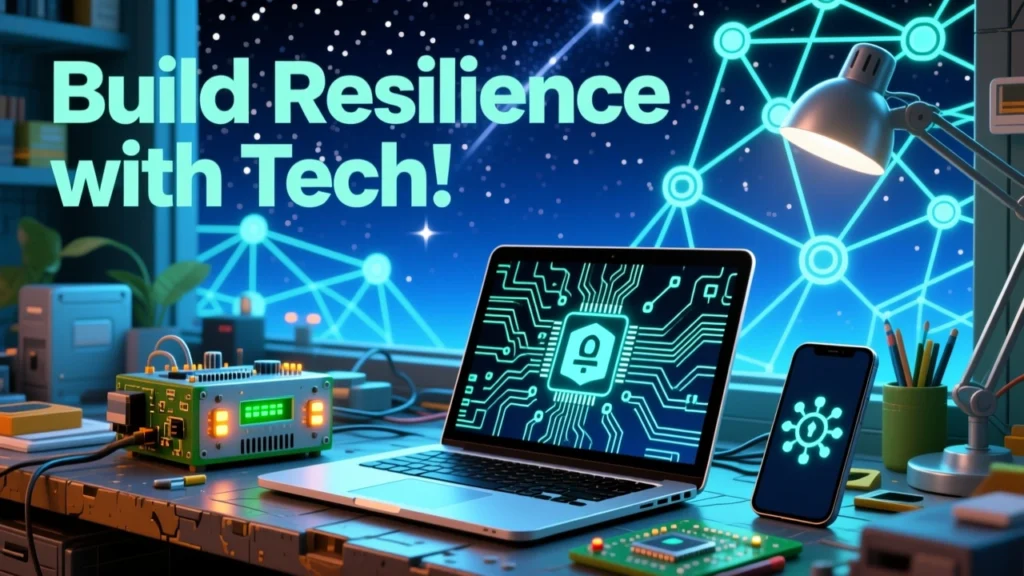Table of Contents
- 1 Survival Prepping: Building Skills for Tough Times
- 1.1 Finding and Starting Survival Communities
- 1.2 Water Purification and Storage
- 1.3 Food Storage and Preservation
- 1.4 Survival Fitness and Training
- 1.5 First Aid and Medical Supplies
- 1.6 Building Emergency Shelters
- 1.7 Security and Self-Defense
- 1.8 Navigation and Communication
- 1.9 Fire Starting and Maintenance
- 1.10 Foraging and Identifying Edible Plants
- 1.11 Hunting, Trapping, and Fishing
- 1.12 Gardening and Sustainable Farming
- 2 Financial Sovereignty: Freedom Through DeFi
- 3 Tech Tools: Powering Resilience
- 4 Join Our Community and Start Today
Views: 1020

Welcome to Bobbiesbunker.com! I’m The DeFi Raider, your guide to breaking free from centralized systems. My journey blends survival skills, financial freedom, and tech know-how. With you, I’m learning and sharing to build stronger lives. This site covers three big areas: Survival Prepping, Financial Sovereignty, and Tech Tools.
We grow together as a community, exploring practical tips and ideas. My survival skills are basic but growing, and my tech knowledge runs deep. Join our Telegram group, Epic AI, DeFi and Technological Tomfoolery, to share and learn. Let’s dive into each section and see what’s ahead!
Survival Prepping: Building Skills for Tough Times

Survival prepping helps you handle emergencies in wilderness survival or urban survival situations which differ from each other. My skills come from camping, hunting, and fishing over years. They’re simple but useful, and I’m eager to learn more with you. From water purification to first aid, we’ll share practical steps. Each topic below offers a starting point for growth.
I use free resources like libraries to improve my knowledge. You can too, and we’ll test ideas together. Our Telegram group is a great place to swap tips. Prepping means being ready for anything, anywhere. Let’s explore these skills to feel confident and secure.
Finding and Starting Survival Communities
Finding survival communities is simple and rewarding. Start online with platforms like Meetup.com or Reddit and search for prepper and survivalist groups and communities to discover people discussing things such as urban survival tips and prepper supplies. Search “prepper groups near me” to locate local meetups for hands-on practice in shelter building techniques or survival gardening. Join our Telegram group, Epic AI, DeFi and Technological Tomfoolery, to connect with others sharing navigation and communication ideas. Be cautious, verify group credibility, and start with public events for safety.
To start your own survival community, invite friends or neighbors to meet in parks or libraries, focusing on practical tips like first aid and medical supplies. Online, create a free group on Facebook or Telegram, sharing food storage and preservation knowledge. Keep discussions positive, emphasizing self-reliance and nurturing community. Regular meetings, online or offline, build trust and skills, preparing everyone for tough times.
Water Purification and Storage
Clean water keeps you alive in emergencies. I know how to filter water using sand, charcoal, and rocks. You layer them in a cut bottle, pour water through, then boil it. Portable filters like LifeStraw work too. Rainwater collection is legal in many places, despite myths.
Storing water needs rust-proof tanks for safety. I’m learning better methods, like finding local streams for practice. Together, we can test simple setups at home. Share your ideas in our Telegram chat. This skill ensures you never run dry in tough times.
Food Storage and Preservation
Keeping food fresh means you eat during crises. I’ve studied salting, canning, smoking, and dehydrating from books. Rub salt on meat to dry it, or seal veggies in jars with heat. Smoking adds flavor while preserving fish. Dehydrating slices fruit thin for air-drying.
My skills here are basic, but I’m experimenting with household items. You can try these too, using kitchen tools. We’ll share recipes and mistakes in our Telegram group. This knowledge cuts reliance on stores. Let’s grow our food-saving skills together!
Survival Fitness and Training
Survival fitness builds strength for tough times. You need a fit body to carry gear or run far. My skills here are basic from camping trips. But I am working on workouts like push-ups and walks. They help you stay ready for emergencies. Start with simple exercises at home. No gym needed. Just time and effort.
We can train together in our Telegram group. Share your routines and progress there. Fitness ties to prepping and even DeFi. A strong mind trades better under stress. Try cardio for stamina and lifts for power. This skill makes you more sovereign. Let’s get moving and grow stronger as a community.
First Aid and Medical Supplies
First aid saves lives when help is far. I know basic CPR: check response, call help, give 30 compressions, then 2 breaths. For big cuts, press clean cloth hard to stop bleeding. Don’t pull out stuck objects like knives, it worsens things. I also understand pain pills like ibuprofen.
I’m practicing CPR and wound care with free guides. You can learn these too, using online videos. Share your progress in our Telegram community. We’ll build confidence in handling emergencies. This skill makes you a helper in tough moments.
Building Emergency Shelters
Shelters protect you from cold, heat, or rain. My knowledge here is mostly theory, but I’m studying natural materials like branches or tarps. You can build a lean-to with sticks and leaves. Urban shelters might use cardboard or blankets. Free resources help us learn fast.
I’ll test simple designs in nearby woods and share results. You can try this at home or in parks. Our Telegram group is perfect for swapping shelter ideas. Together, we’ll get better at staying safe. This skill ensures you have a roof anywhere.
Security and Self-Defense
Staying safe means being aware and prepared. I have a conceal-and-carry permit and some hunting experience. In home defense, secure weapons so only you access them. Perimeters stop intruders from surrounding you. My combat skills need work, but I’m learning theory.
We can study free online courses on awareness together. Share your tips in our Telegram chat for better strategies. I’ll post what I learn from practice. This knowledge keeps you and your loved ones safe. Let’s grow stronger in defense skills.
Knowing your way and staying connected is key. I use offline GPS on Android for no-signal areas. Maps need legends and scales to read right. The sun rises east, sets west; Polaris guides north. I’m exploring mesh networks like Bluetooth or LoRaWAN for local chats.
I’ll test navigation tricks in local woods and share them. You can practice with free apps or stars at night. Our Telegram group is great for communication ideas. We’ll learn secure messaging together. These skills keep you on track and in touch.
Fire Starting and Maintenance
Fire gives warmth and cooks food in emergencies. My skills here are basic, but I’m studying friction methods like bow drills. You carve a bow, spin a stick, and spark tinder. Flint and steel work too with practice. Free videos online teach these well.
I’ll try low-cost demos in safe spots and post results. You can experiment with sticks or rocks at home. Share your fire tips in our Telegram group. We’ll learn what works best together. This skill lights up survival in any setting.
Foraging and Identifying Edible Plants
Finding food in nature keeps you fed. I know basics, like for example dandelions are safe to eat however make sure you obtain them from places with no pesticides or chemical fertilizers and other contamination. Library books teach which plants are good or bad. Look-alikes can trick you, so study carefully. Free guides online help us learn what’s safe.
I’ll research local plants and share findings with you. Try foraging in your yard or park with a guidebook. Our Telegram community can swap plant photos and tips. We’ll grow better at spotting food. This skill feeds you when stores are gone.
Hunting, Trapping, and Fishing
Catching food builds self-reliance in crises. I hunt with guns, know bow basics, and clean game safely. Traps use wire snares for small animals. Fishing with worms you find outside or minnows you caught in works well. I’m learning more trapping tricks with free guides.
I’ll practice in local areas and share how-to videos and my own guides. You can try fishing in nearby streams or hunting safely. Join our Telegram group to exchange tips on baits or snares. We’ll improve together. These skills keep your table full anywhere.
Gardening and Sustainable Farming
Growing food cuts reliance on others. I know how to start seeds in damp towels and water them. Compost from kitchen scraps feeds plants. NPK(Nitrogen, Phosphorous, and Potassium) ratios balance nutrients for growth. Crop rotations keep soil strong, and some plants have genders which need both to produce seeds.
I’m gonna be testing small gardens with cheap seeds and sharing progress. You can grow herbs in pots at home. Our Telegram group is great for gardening ideas. We’ll learn what grows best together. This skill ensures food security for life.
Financial Sovereignty: Freedom Through DeFi

Financial sovereignty means controlling your money without banks. I’ve been in DeFi since 2013, using tools like Bitcoin and DEXs. Centralized systems print money for free, while we work hard. Self-custody keeps your assets safe. We’ll learn DeFi together to stay free.
My tech skills help me to explain complex ideas simply. From self custodial wallets to DAOs, I’m sharing what I know and learning more. Join our Telegram group to talk crypto strategies. This section empowers you to own your wealth. Let’s dive into these topics now!
Cryptocurrencies and Blockchain
Cryptocurrencies like Bitcoin and Litecoin run on blockchain for secure trades. Bitcoin uses Proof of Work, solving math to verify deals. Litecoin is faster with better privacy. Tokens vary: some are for utility, others for fun. I’m exploring new coins with you.
We’ll test wallets like Metamask and TrustWallet and share tips. Blockchain can work without internet for emergencies. Our Telegram group discusses new coins and risks. This knowledge frees you from bank control. Let’s grow our crypto skills together!
Decentralized Exchanges and Wallets
DEXs let you trade without middlemen, unlike bank-run exchanges. They’re private, cheap, and run 24/7. Wallets like Trust Wallet hold your coins safely. No KYC means more freedom. I use DEXs and learn their tricks daily.
I’ll share how to swap tokens safely and avoid scams. You can try DEXs with small amounts to learn. Our Telegram chat is great for wallet tips. We’ll find the best platforms together. This skill keeps your money in your hands.
Lending, Borrowing, and Yield Farming
DeFi lets you lend or borrow without banks. Aave offers loans using your crypto as collateral. Alchemix loans pay themselves back over time. Yield farming earns you fees by adding to pools. Risks like price drops need careful watching.
I’m testing Aave and sharing what works or fails. You can start with small loans to learn safely. Join our Telegram group to swap yield ideas. We’ll learn smart ways to grow money. This skill builds wealth without centralized control.
Smart Contracts and DAOs
Smart contracts run on chains such as Ethereum and other similar chains and auto-execute deals when rules are met. They can have bugs, so external code audits are key. DAOs let token holders vote on changes, like new features. They could make voting fairer everywhere. I’m diving deeper into their code.
I’ll share simple contract uses and DAO voting tips. You can explore DAOs with free tools online. Our Telegram group discusses new projects. We’ll learn governance together. This skill shapes a freer financial future.
Risks and Future of DeFi
DeFi has risks like scams or contract bugs. Rug pulls steal funds when devs vanish. Regulatory rules are easing as governments accept crypto. In the future they could replace banks entirely. I’m studying risks to share safe paths.
We’ll test secure platforms and share warnings in our Telegram group. You can learn scam signs with free guides. Together, we’ll spot safe DeFi projects. This knowledge protects your wealth. Let’s build a strong DeFi future!
Tech Tools: Powering Resilience

Tech tools make survival and freedom easier. My tech skills are strong, from circuits to blockchain. I’m learning new systems like mesh networks for emergencies. These tools tie into prepping and DeFi for full sovereignty. We’ll explore them as a team.
I use free resources to grow my tech knowledge. You can too, with online tutorials or local libraries. Our Telegram group, Epic AI, DeFi and Technological Tomfoolery, is perfect for sharing tech tips. Let’s build smarter solutions together!
Decentralized Communication
Staying connected without internet is vital in crises. Mesh networks use Bluetooth for local chats or LoRaWAN for long-range signals. PGP encryption keeps messages private on insecure platforms. I’m studying how to build these from scratch. We’ll learn what works best.
I’ll test simple setups and share in our Telegram group. You can try free apps for secure messaging. We’ll swap code or hardware ideas online. This skill ensures you stay in touch anywhere. Let’s grow our communication tech together!
Blockchain for Emergencies
Blockchain lets you trade even if systems fail. Nodes can sync and transactions can still be nt without traditional internet, keeping deals alive. This ties to DeFi for financial freedom. I’m exploring blockchain setups for outages. You can learn these with free software guides.
I’ll share simple blockchain uses in our Telegram chat. Try small transactions to practice safely. We’ll test outage-proof systems together. This skill keeps your money moving in crises. Let’s build this tech for resilience!
Circuits and Custom Tech
Basic circuits power custom survival tools. I know enough to tinker with small projects. Building hardware or software for networks interests me. Free schematics online guide my learning. We can create simple tech for prepping needs.
I’ll share circuit projects and test them with you. Try building with cheap parts at home. Our Telegram group is great for tech ideas. We’ll learn what’s practical together. This skill makes you a tech creator for survival.
Join Our Community and Start Today
Bobbiesbunker.com is about learning and growing together. My skills in survival are basic but honest, and my tech knowledge is deep. We’ll learn new tricks, from fire starting to DeFi trading. Share your journey in our Telegram group, Epic AI, DeFi and Technological Tomfoolery. Let’s build a freer, stronger life!

Pick a topic above and dive in. Try a water filter or a wallet setup today. Share your wins or questions with us. Every step makes you more sovereign.
The bunker isn’t buried in fear, it’s encrypted, in your mind, filled with courage!
